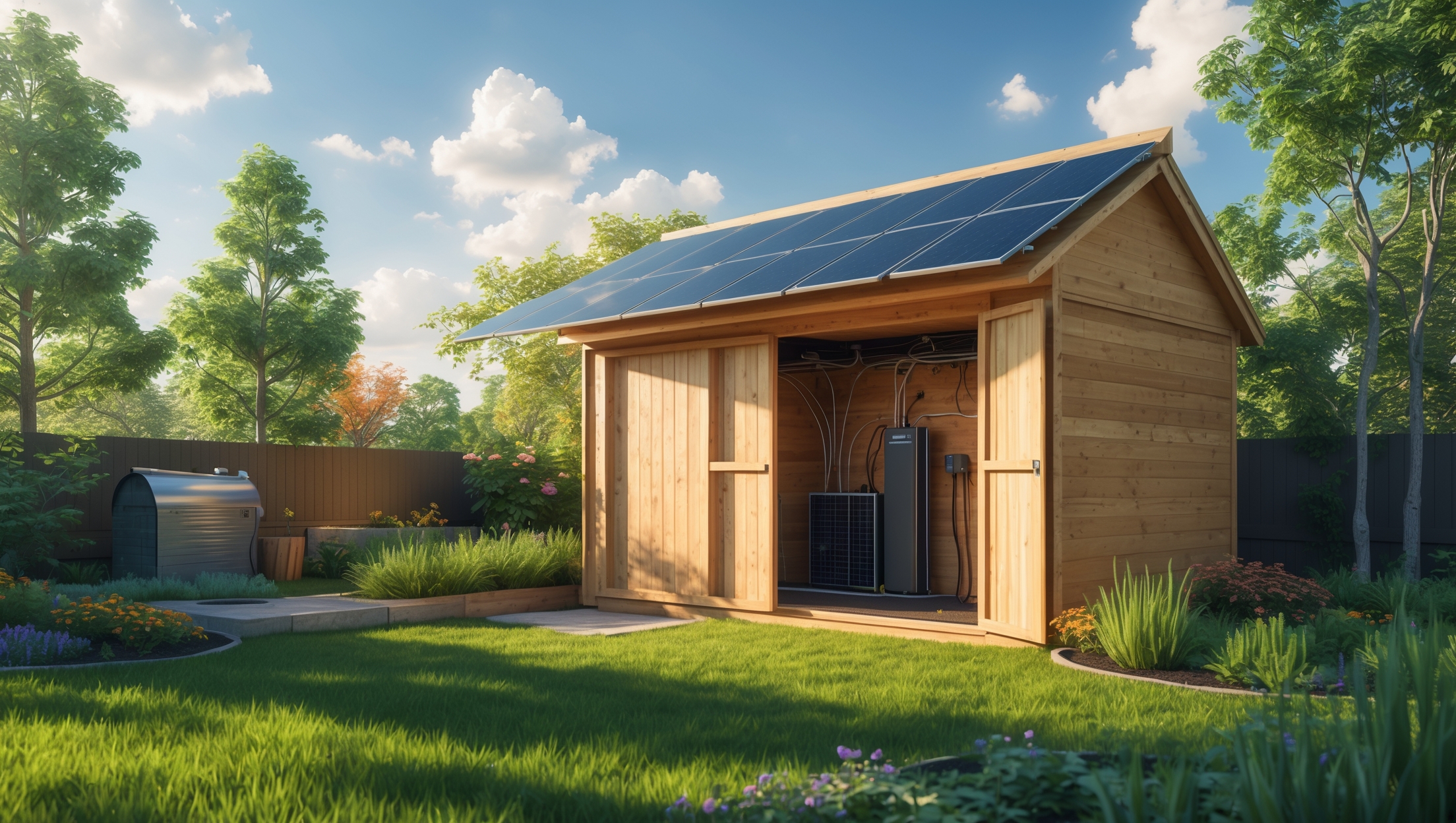Introduction: Why Insurance Matters for DIY Solar Battery Backup Sheds
As the adoption of sustainable living and green technologies accelerates, more homeowners are building their own solar battery backup sheds to boost energy resilience and independence. These DIY projects can significantly reduce reliance on the grid, enhance emergency preparedness, and contribute to a cleaner energy future. However, integrating advanced energy storage into your property introduces a new set of risks—fire, theft, weather damage, and even liability issues—that many homeowners overlook until it’s too late. Conventional home insurance policies often do not cover DIY installations or externally located battery sheds, leaving you financially vulnerable if disaster strikes. This comprehensive guide demystifies the insurance landscape for DIY solar battery backup sheds, equipping you with the knowledge to secure the right coverage, meet compliance requirements, and proactively manage risks. Whether you’re planning your first battery shed or upgrading an existing setup, understanding insurance essentials is as critical as technical know-how for safeguarding your green energy investment and your peace of mind.
Understanding the Unique Risk Profile of DIY Solar Battery Backup Sheds
Why Battery Sheds Are Different from Other Outbuildings
Unlike a typical garden shed, a solar battery backup shed contains high-capacity lithium-ion or lead-acid batteries, sophisticated charge controllers, inverters, and often wiring connecting to solar arrays and the home’s subpanel. These components present unique hazards:
- Fire risk: Battery thermal runaway, electrical shorts, or improper ventilation can spark fires.
- Theft and vandalism: Batteries and solar equipment are valuable and increasingly targeted by thieves.
- Weather exposure: Sheds located outside the main structure are susceptible to wind, hail, flooding, and wildfires.
- Liability: If a fire or battery incident affects neighboring properties, you could be held responsible.
- DIY risks: Non-professional installation or code violations may void warranties and insurance eligibility.
Common Insurance Gaps for DIY Battery Sheds
Many homeowners assume that their standard policy automatically covers all outbuildings and improvements. However, insurance carriers often exclude or limit:
- Structures built without permits or professional inspection.
- Non-standard electrical or energy storage installations.
- Detached structures located far from the main dwelling.
- Business or income-generating uses (such as selling power back to the grid).
This makes it essential to proactively address insurance before a loss occurs.
Types of Insurance Coverage to Consider
1. Dwelling Extension or Other Structures Coverage
Most home insurance policies include limited coverage for detached structures (typically 10% of the main dwelling’s coverage). However, you must disclose the presence and use of your battery shed. If the shed is used to store high-value equipment, you may need to increase this limit or purchase a specific rider.
2. Equipment Breakdown Coverage
This optional add-on covers damage to home systems resulting from mechanical failure, power surges, or electrical breakdown. Verify with your insurer that solar batteries, inverters, and charge controllers are included—some policies exclude renewable energy equipment or require additional documentation.
3. Fire and Natural Disaster Coverage
Standard policies often cover fire, wind, hail, and some weather-related events. However, battery sheds located in wildfire-prone or flood-risk areas may require special endorsements or separate policies (e.g., flood insurance).
4. Theft and Vandalism Coverage
If your shed is not secured or lacks proper locks and alarms, theft claims may be denied. Some insurers require evidence of forced entry and may limit payouts for theft from outbuildings.
5. Liability Protection
If a battery fire causes damage beyond your property or injures someone, liability coverage protects you from lawsuits. Ensure your coverage limits are sufficient given the potential risks.
6. Product and Installation Warranties
While not insurance, manufacturer warranties for batteries and inverters can offset repair or replacement costs. However, DIY installation may void these warranties unless you follow all specified guidelines and use approved components.
Critical Steps to Ensure Insurability
1. Documentation and Permits
Always obtain the appropriate building and electrical permits for your battery shed. Maintain records of:
- Permit applications and approvals
- Design plans and electrical diagrams
- Manufacturer datasheets for all equipment
- Receipts and proof of purchase
- Inspection reports (if applicable)
Insurers often request this documentation to determine eligibility and settle claims.
2. Code Compliance and Best Practices
Install your shed and battery system in accordance with:
- National Electrical Code (NEC) Article 706 (Energy Storage Systems)
- Local fire and building codes
- Manufacturer installation instructions
Consider a third-party inspection by a licensed electrician, even for DIY projects. Document compliance with photos and signed checklists.
3. Security and Loss Prevention Measures
Enhance your insurability and reduce premiums by implementing:
- Heavy-duty locks and reinforced doors
- Motion-activated lighting and security cameras
- Fire-rated construction materials and smoke detectors
- Proper ventilation and temperature control
- Flood barriers if in a high-risk zone
Insurers often offer discounts or broader coverage for well-protected installations.
How to Shop for the Right Insurance Policy
1. Disclose All Details Upfront
Honesty is essential. Inform your agent about:
- The existence of the battery shed and its location
- Type and capacity of batteries
- Whether you installed it yourself or used a contractor
- Connection to the main electrical system
- Any business or grid-tied activities
Failure to disclose can result in denied claims or policy cancellation.
2. Request Specific Written Confirmation
Ask your agent to confirm in writing that your shed and its contents are covered, including:
- Covered perils (fire, theft, wind, etc.)
- Limits and exclusions for detached structures and energy storage systems
- Any conditions or documentation required for claims approval
Don’t rely on verbal assurances or generic policy language.
3. Compare Specialized Insurers
Some insurers specialize in green technologies or offer policies tailored for solar and battery systems. Research regional providers or green building insurance programs. Rates and coverage can vary widely, so obtain at least three quotes and compare deductibles, exclusions, and customer service reviews.
4. Update Your Policy as Your System Evolves
If you upgrade to larger batteries, add solar panels, or expand the shed, notify your insurer and update your coverage. Undocumented improvements may not be covered in the event of a claim.
Risk Mitigation Strategies to Lower Insurance Costs
1. Fire Prevention and Suppression
Install fire extinguishers rated for electrical and lithium battery fires. Consider an automatic fire suppression system if your battery capacity exceeds 20 kWh or your shed is in a fire-prone area. Use non-combustible wall and roof materials, and maintain clear defensible space around the shed.
2. Environmental Controls
Keep batteries within manufacturer-specified temperature and humidity ranges. Use climate control or passive ventilation to prevent condensation, which can trigger electrical shorts. Elevate batteries above flood level if in a flood-prone zone.
3. Routine Inspections and Maintenance
Document regular inspections for corrosion, leaks, wiring integrity, and fire hazards. Keep a log of maintenance and any repairs. This record can support insurance claims and demonstrate responsible ownership.
4. Enhanced Security Measures
Install visible security cameras and signage. Use tamper-resistant fasteners on doors and panels. Engage neighbors in a watch program if theft is a risk in your area.
Handling Claims: What to Do If Disaster Strikes
1. Immediate Response
If you experience fire, theft, or other loss, prioritize safety. Evacuate the area and call emergency services as needed. After the immediate danger has passed, secure the site to prevent further loss.
2. Documentation
Take photos and video of the damage before cleanup. Gather all documentation: permits, purchase receipts, maintenance logs, and inspection reports. This evidence is crucial for a smooth claims process.
3. File Promptly and Communicate Clearly
Notify your insurer as soon as possible. Provide all requested documentation and be honest about the circumstances. Cooperate with adjusters and provide access for inspection if needed.
4. Appeals and Disputes
If your claim is denied, review the policy language and consult your agent. If necessary, seek legal or independent adjuster assistance. Thorough documentation and compliance with codes greatly improve your chances of a favorable outcome.
Special Considerations: Off-Grid, Rental, and Business Uses
1. Off-Grid Homes
Insurance options for fully off-grid homes are more limited. Some carriers do not insure properties without a grid connection. Research specialty insurers and be prepared for higher premiums or stricter requirements.
2. Rental Properties
If you rent out your home or accessory dwelling and rely on a battery backup shed, you may need landlord insurance with specific endorsements. Inform tenants of safety protocols and maintenance schedules.
3. Business or Income-Generating Uses
Generating income from solar (e.g., net metering, battery leasing) can shift your risk profile. Consult your insurer about business-use exclusions and consider a commercial policy if applicable.
Conclusion: Building Resilience with Smart Insurance Choices
Installing a DIY solar battery backup shed is a transformative step toward sustainable living, energy independence, and climate resilience. However, the technical achievement of building and wiring your own energy storage system is only half the battle. Protecting that investment with the right insurance coverage is essential for long-term peace of mind. By understanding your shed’s unique risks, proactively disclosing details to your insurer, and implementing robust risk mitigation strategies, you can dramatically reduce both your premiums and your exposure to catastrophic loss. Take the time to gather documentation, stay code-compliant, and invest in quality security and fire prevention measures. Regularly review and update your policy as your system evolves, and never hesitate to ask for written confirmation of coverage. With comprehensive risk management in place, your DIY solar battery backup shed can deliver safe, reliable, and sustainable power for years to come—no matter what challenges the future holds. The time and effort you invest in insuring your shed today will pay dividends in financial security, operational continuity, and true sustainability in your green home journey.





If I already have homeowners insurance, how can I find out if my policy specifically excludes coverage for DIY solar battery backup sheds or lithium-ion batteries stored outside the main residence?
To determine if your homeowners insurance covers DIY solar battery backup sheds or lithium-ion batteries stored outside your main residence, review your policy documents for any exclusions related to outbuildings, solar installations, or specific battery types. If it’s unclear, contact your insurance agent or provider directly and ask about coverage for detached structures and lithium-ion batteries. They can clarify what’s covered and advise if you need to add or adjust your policy.
For those of us in areas prone to extreme weather like hail or wildfires, are there specific insurance endorsements or add-ons to look for that would fully cover weather-related damage to an outdoor battery shed?
Absolutely, for regions with high risk of hail or wildfires, ask your insurer about endorsements like ‘extended perils’ or ‘specific structure coverage’ for outbuildings. These can include damage from wind, hail, fire, and even smoke. Also, consider ‘equipment breakdown’ coverage for the batteries themselves. Be sure to clarify the coverage limits, exclusions, and whether outdoor battery sheds qualify under your main policy or need a separate rider.
If I’m planning to build a solar battery backup shed myself, are there certain insurance providers known to better support coverage for DIY projects, or should I expect higher premiums regardless?
Insurance options for DIY solar battery backup sheds can vary widely. Some providers are more open to insuring DIY projects, especially if you follow local codes and get proper inspections. However, many insurers may still charge higher premiums or impose restrictions, since DIY builds are often seen as higher risk. It’s best to contact multiple providers, explain your project in detail, and ask about their specific policies for DIY installations.
I noticed the article says battery sheds are more prone to theft and weather damage than regular outbuildings. Are there any recommended security or weatherproofing upgrades that might help lower insurance premiums for these sheds?
Absolutely, insurers often look favorably on added security and weatherproofing for battery sheds. For security, consider reinforced locks, alarm systems, security cameras, and motion-sensor lighting. Weatherproofing upgrades like metal roofing, proper ventilation, fire-resistant materials, and raised foundations to avoid flooding can help, too. Document any improvements and discuss them with your insurance provider, as these measures may qualify you for lower premiums.
You talked about liability if an incident in my shed affects neighboring properties. What kind of coverage would protect me in that situation, and is it usually a separate policy or an add-on?
If your solar battery backup shed causes damage or injury to neighboring properties, personal liability coverage is what protects you. This is commonly part of your standard homeowners insurance, but because sheds with electrical systems can be considered higher risk, you might need to specifically add or extend coverage for outbuildings and related activities. It’s best to speak with your insurance provider to ensure your policy includes sufficient liability protection for your setup.